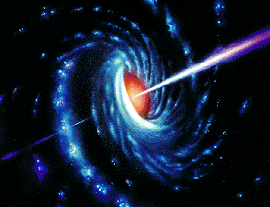At the heart of most galaxies lurks a black super giant, a massive black hole, usually about two percent of the mass of the entire galaxy it rules. These objects seemed to have evolved very early in the cosmos. Some are so energetic they can be seen powering quasars across billions of years of time and space. But scientists only know one way for a black-hole to form, and those objects have only a few solar masses. How do they get to a million or a billion times that?
(CSM) — Now, scientists have added a new ingredient that they say could account for a substantial portion of a supermassive black hole’s heft: stars wrested from binary star systems that wandered too close for their own good. … One star in a binary paring gets ejected from the galaxy at extraordinary speeds. The star left behind orbits even closer to the black hole, joining other stars the black hole has orphaned. … At some point, the zone in which the orphans orbit reaches its capacity. After that, gravitational interactions between all the orphans virtually guarantee that when a new star enters the zone, another star must vanish into the black hole itself, signaling its end with a brief flash of high-energy radiation.
Bada-bing, bada-bang! That means not only would the holes grow, but the galaxy would emit stars like electrons boiling off a cathode, in elapsed time of course.


Just Keep Eating.
I was always told that milk would make me grow up to be big & strong but it turns out it was stars I should have been having…
We always see black holes depicted sucking up matter from a nearby star, and that lovely swirling pattern. Just once I’d love to see what would happen if a star rammed into a black hole dead-on. The devastation would be incredible.
It doesn’t have to be stars ripped from a binary pair, correct? Wouldn’t gravitational interactions between stars in the central cluster near the center of galaxies send individuals falling toward the singularity pretty constantly (in cosmic terms)? I always thought the stars jostled each other incessantly.
As an aerospace engineer (non-practicing), it pretty simple: everything in the cosmos revolves around a larger object. Our moon revolves around the earth, the earth revolves around the sun, and our solar system revolves around a black hole in the center of our galaxy. As the singularity that is known as ‘a black hole’ gains enough mass (and therefore energy), it explodes. And all hell breaks loose. Astrophysics 101.